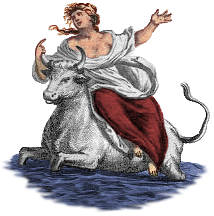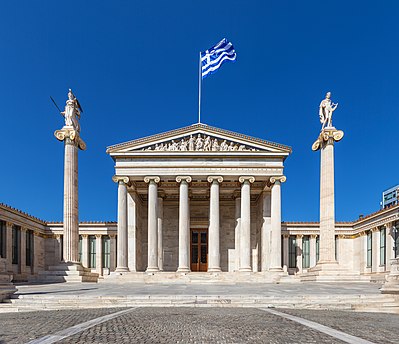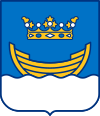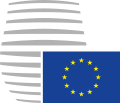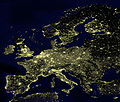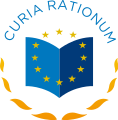Portal:European Union
Introduction
The European Union (EU) is a supranational political and economic union of 27 member states that are located primarily in Europe. The Union has a total area of 4,233,255 km2 (1,634,469 sq mi) and an estimated total population of over 449 million. The EU has often been described as a sui generis political entity combining the characteristics of both a federation and a confederation. Containing 5.8% of the world population in 2020, EU member states generated a nominal gross domestic product (GDP) of around US$16.6 trillion in 2022, constituting approximately one sixth of global nominal GDP. Additionally, all EU states except Bulgaria have a very high Human Development Index according to the United Nations Development Programme. Its cornerstone, the Customs Union, paved the way to establishing an internal single market based on standardised legal framework and legislation that applies in all member states in those matters, and only those matters, where the states have agreed to act as one. EU policies aim to ensure the free movement of people, goods, services and capital within the internal market; enact legislation in justice and home affairs; and maintain common policies on trade, agriculture, fisheries and regional development. Passport controls have been abolished for travel within the Schengen Area. The eurozone is a group composed of the 20 EU member states that have fully implemented the economic and monetary union and use the euro currency. Through the Common Foreign and Security Policy, the union has developed a role in external relations and defence. It maintains permanent diplomatic missions throughout the world and represents itself at the United Nations, the World Trade Organization, the G7 and the G20. Due to its global influence, the European Union has been described by some scholars as an emerging superpower. In 2012, the EU was awarded the Nobel Peace Prize. The United Kingdom became the only member state to leave the EU, in 2020; ten countries are aspiring or negotiating to join it. (Full article...) Selected articleThe Treaties of Rome are two of the treaties of the European Union signed on March 25, 1957. Both treaties were signed by The Six: Belgium, France, Italy, Luxembourg, the Netherlands and West Germany. The first established the European Economic Community (EEC) and the second established the European Atomic Energy Community (EAEC or Euratom). They were the first international organisations to be based on supranationalism, after the European Coal and Steel Community (ECSC) established a few years prior. The treaties came into force on 1 January 1958 and the EEC treaty has been amended on numerous occasions (see Treaties of the European Union); It has since been renamed from The Treaty establishing the European Economic Community to the The Treaty establishing the European Community. However the Euratom treaty has seen very little amendment due to the later sensitivity surrounding atomic energy amongst the European electorate. Selected picturePhotograph credit: Thomas Wolf The Academy of Athens is Greece's national academy and the highest research establishment in the country. Established on 18 March 1926, it operates under the supervision of the Ministry of Education and Religious Affairs.
This picture shows the main building of the Academy, a neoclassical building between Panepistimiou Street and Akadimias Street in the centre of Athens and one of the city's major landmarks. The building was designed as part of an architectural "trilogy" in 1859 by Danish architect Theophil Hansen, along with the University and the National Library. The Greek neoclassical sculptor Leonidas Drosis sculpted the principal multi-figure pediment sculpture, on the theme of the birth of Athena, based on a design by painter Carl Rahl. Two columns on either side of the portico feature statues of Athena on the left and Apollo on the right, also designed by Drosis.
Did you know?...that France possesses the largest exclusive economic zone (EEZ) in the world? ...that Monaco, San Marino, and Vatican City all mint their own euro coins, with their own national symbols on the back? ...that Turkey's two most famous weightlifters, Naim Suleymanoglu and Halil Mutlu are only two of four weightlifters in the world to have won 3 gold medals in 3 olympics? Selected cityHelsinki is the capital and largest city of Finland. It is located in the southern part of Finland on the shore of the Gulf of Finland, by the Baltic Sea. The population of the city of Helsinki is 564,643 (31.10.2006). The Helsinki urban region contains the neighboring cities of Espoo, Vantaa and Kauniainen, which are together called the Capital Region. This area has a total population of approximately 997,291 citizens. The Greater Helsinki area contains several more neighboring cities and has a population of approximately 1,293,093, which means that one out of every four Finns lives in the Greater Helsinki area. Helsinki is Finland's international gateway. The city is the country's nerve center for business, finance, fashion, medicine, entertainment, media, culture and intellectual discourse. There is a large and varied collection of museums, galleries and performance spaces. The city has Finland's largest foreign population in terms of real numbers and percentage of population. There are over 130 nationalities resident in Helsinki. General imagesThe following are images from various European Union-related articles on Wikipedia.
TopicsFeatured contentFeatured articles
Featured lists
Featured contentGood articles
CategoriesRelated portalsAssociated WikimediaThe following Wikimedia Foundation sister projects provide more on this subject:
Discover Wikipedia using portals |



